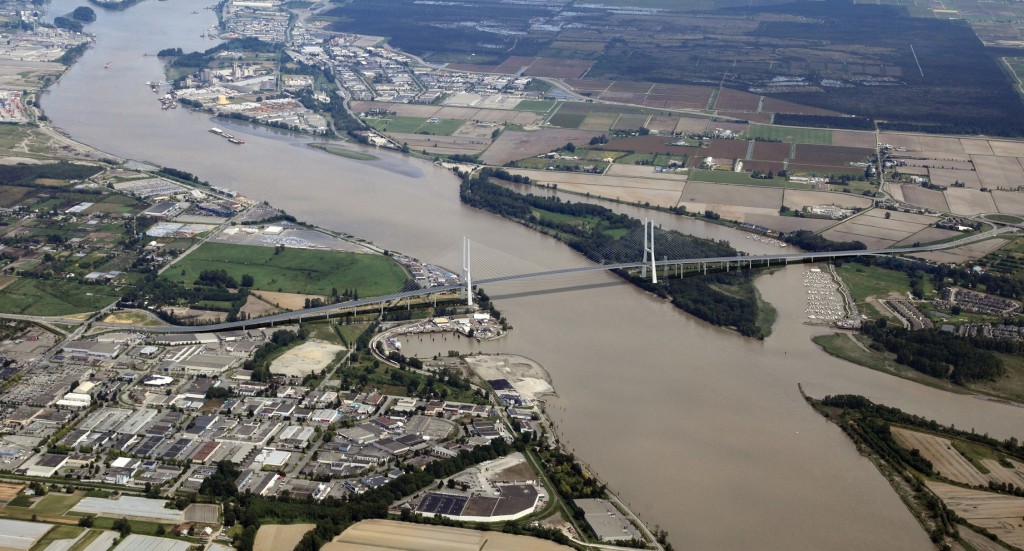
$3.5B Massey Tunnel replacement project gets support
By On-Site Magazine
Asphalt Bridges Concrete Construction Construction Materials Infrastructure P3s Roads bridges British Columbia construction infrastructure Massey Tunnel video
Artist’s conception of the proposed $3.5B 10-lane bridge to replace the Massey Tunnel between Richmond and Delta in British Columbia
There is strong public support to replace the Massey Tunnel with a $3.5 billion, 10-lane bridge, according a recently released report on the public consultation process done by the Government of British Columbia.
The report confirms residents are in favour of capacity improvements to address congestion, the proposed interchange improvements, and the transit, cycling and pedestrian measures to encourage greener transportation choices to replace the existing 55-year-old tunnel.
“We’ve heard from thousands of British Columbians during the last three years of consultations, and their input has helped shape the George Massey Tunnel Replacement Project,” said Transportation and Infrastructure Minister Todd Stone. “The input we’ve most recently received confirms support for the environmental benefits of the project, and for much-needed capacity improvements that will benefit the entire region.”
The project scope includes a new, 10-lane bridge and related Highway 99 improvements between Bridgeport Road in Richmond and Highway 91 in Delta. The Province plans to fund the Project at least in part with user tolls. Funding partnerships are also being explored.
Subject to environmental review, construction is expected to begin in 2017, with the new bridge completed by 2022. The cost is estimated at $3.5 billion. Direct employment created by the project is estimated at 9,000 jobs.
______________________________________
FLY THROUGH VIDEO of the proposed bridge
_______________________________________
In 1959, Queen Elizabeth opened the George Massey Tunnel to overwhelming support. The 629-metre long tunnel was considered an engineering marvel and was the first project in North America to use immersed tube technology. Six concrete segments, each measuring 344 feet long and weighing 18,500 tons, were constructed on a dry dock, connected, sealed and sunk into place.
The Tunnel was originally a tolled crossing, with travellers paying $0.50 per trip. Tolls were removed in 1964 when the majority of the tunnel’s construction costs had been repaid. George Massey himself paid the last toll. In 1982, counterflow measures were introduced, using a reversible lane system to increase traffic flow during peak periods, which continues to operate today. Limited seismic upgrades were made in 2006, including the installation of a state of the art advanced earthquake warning system.
“Tsawwassen First Nation is very supportive of the plan to replace the George Massey Tunnel,” said Tsawwassen First Nation Chief Bryce Williams. “Tsawwassen First Nation is building a sustainable and vibrant economic future – one that is integrated with the rest of the region. Travel times to shop, to work, or to live on Tsawwassen Lands depend largely on replacing the aging tunnel with a bridge designed to handle current and future growth in our corner of the Lower Mainland. We also need to make sure that the project has the appropriate community consultation and environmental reviews in order to minimize any impact on our territory, our treaty rights, and the Fraser River fishery, and we will be looking to ensure that a rigorous assessment does take place.”
“The Province’s initial consultations with the Richmond Farmers Institute and continued inclusion as a stakeholder of the new bridge crossing over the existing alignment has highlighted the importance of agriculture in our community,” said Richmond Farmers Institute president Todd May. “We appreciate the ongoing dialogue in addressing the impacts and concerns of Richmond’s farming community and ensuring the significant contributions of agriculture and its viability continue now and in the future.”
Other findings from the recent consultation include:
- General support for tolling as a funding mechanism, although many participants suggested that tolling should be applied in the context of a regional tolling policy, and some participants opposed any toll.
- Strong support for also using other funding sources such as a federal funding contribution and contributions from Port Metro Vancouver.
- Comments about potential increased traffic congestion at the Oak Street Bridge and to a lesser extent, other Fraser River North Arm crossings.
- Interest in additional transit improvements including timing for extending rapid transit in the future. Some participants expressed a preference for transit-only improvements instead.
- Keen interest in reducing greenhouse gas emissions, and how the project will contribute to this.
- Questions about tunnel decommissioning and the potential effects of increased marine traffic/industrialization of the Fraser River if the tunnel is removed.
“Our province has had incredible growth in the last 50 years. We are one of the most desirable places to live and work in the world and that growth is going to continue,” said Ocean Trailer president Sid Keay. “It’s absolutely vital that our infrastructure catch up and be able to keep up with that growth. The movement of people and cargo in a safe, timely and cost effective manner is vital to the quality of life we British Columbians deserve. The tunnel replacement with a modern new bridge structure will go a long way to doing just that.”
The next step for the project is the submission of the formal application for environmental assessment to the Province’s Environmental Assessment Office, followed by a public comment period on the environmental application. That will happen in late spring or early summer. Around the same time, the Province also intends to issue a Request for Qualifications in preparation for the future procurement process.
In the meantime, the project team will continue to meet with local and regional governments, and other important stakeholders including cycling groups, farmers and TransLink to work through continuing project scope refinements.
The Consultation Summary Report for Phase 3 of project consultations is available in the project’s document library at: http://engage.gov.bc.ca/masseytunnel/documentlibrary/





